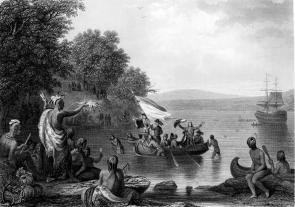Landing of Henrick Hudson, 1609
A Spotlight on a Primary Source by Martin, Johnson & Co.
In 1609, Henry Hudson was chosen by the Dutch East India Company to search for a passage to Asia. In September of that year, Hudson landed on the shores of the river that would be named for him and claimed the lands along it for the Dutch. This nineteenth-century engraving, based on a painting by Robert W. Weir (1803–1889), an American artist of the Hudson River School, depicts the English explorer’s anchoring on the Hudson River. Hudson and his men approach the shore in a small boat, signaling their arrival and claim with a horn’s blow and the Dutch flag. Their ship, the Half Moon, looms in the background and dwarfed Indian canoes paddle out to meet it.
The logbook of Hudson’s ship records the landing on September 5: "Our men went on Land there, and saw great store of Men, Women and Children," and notes that the "people of the countrie" were "very civill" and "very glad of our coming."[1] The image conveys the native peoples’ eagerness to meet the group of Europeans, with several men helping to pull the boat ashore as others look on. They offered Hudson’s men food, tobacco, and other goods, but Hudson "durst not trust them."[2] Hudson and his crew ascended the river northward for ten days, meeting and trading with native groups, before returning to Europe. Hudson’s exploration of the river had profound implications for both Europeans and Native Americans. The waterway would prove to be an important route to trade, colonization, and conflict.
[1] Robert Juet, "The Third Voyage of Master Henry Hudson, toward Nova Zembia, and at his Returne, his Passing from Farre Islands to Newfound Land, and along to Fortie-foure Degrees and Ten Minutes, and thence to Cape Cod, and so to Thirtie-three Degrees; and along the Coast to the Northward, to Fortie-two Degrees and an Halfe, and up the River Neere to Fortie-three Degrees," in Benson John Lossing and Woodrow Wilson, Harper Encyclopaedia of United States History from 458 A.D. to 1909 (New York: Harper and Brothers, 1905), 444.
[2] Juet, "Third Voyage," in Harper Encyclopaedia, 443.

